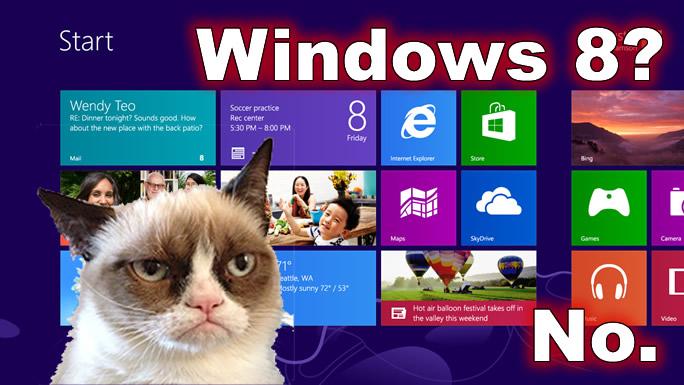Will 90 percent of users always hate Windows 8?


It came and went without me noticing, but I've been using Windows 8 as a full-time operating system for over year now. I installed the Consumer Preview on February 29th 2012, and I've stuck with Windows 8 ever since.
I have been pretty positive about Windows 8 since about the time the penny dropped and I realised what Microsoft was doing: the PC market is going away, and Microsoft had to produce a product that straddles the PC and post-PC transition.
Read: "Start8 and ModernMix -- Windows 8's last, best hope for normality on the desktop"
For me, Windows 8 does a good job at being a desktop operating system. I use it every day and it's robust, solid, fully-featured and capable. At a kids party last weekend one of the dads asked me if he should downgrade his new Windows 8 laptop to Windows 7 — I didn't even hesitate before saying "keep Windows 8."
But something happened to me this week that has made me wonder whether actually Windows 8 is actually a total miss-hit for 90 percent of consumers.
Metro-style
What happened was that a good friend of mine directed me to a book she had been reading called Simple and Usable by Giles Colborn. She pointed me to a section in the book where Colborn breaks down the following:
- A tiny percentage (say one percent) of users are experts, with a high tolerance for learning.
- A few more (say nine percent) of users are willing adopters — they have an expectation that the product will meet their needs, and some (albeit low) tolerance for learning.
- The remaining 90 percent of users just use technology to get a job done and have no tolerance for learning at all. These are mainstreamers.
This method, by the way, explains Apple quite precisely. Apple's products don't do much, but what they do do requires no cognitive load or expectation of understanding drawing from prior experience whatsoever. For example, my son who at nine months of age would happily flick around the photo app on my iPad. Nine months!
That realisation made my heart sink as I realised the mistake that I'd been making with Windows 8: I actually cared about trying to make it work and did, although that wasn't an entirely deliberate and conscious process. Although Colborn doesn't put it exactly like this, 90 percent of the people (particular consumers) who will sit down in front of Windows 8 most likely will not care a jot about learning how it works or about any of the history and thought that's gone into making what's technically a very clever product.
Guilt
I met with the CEO of an IT support company last week who I asked about uptake of Windows 8 and he, perhaps surprisingly, told me he was happily rolling out Windows 8 to his customers. I mentioned that I was surprised — he replied with "of course, we just install this 'yadda-yadda' app that puts the Start button back." (I can't remember the name of the app he used, but my ZDNet colleague David Gewirtz talks much more on this topic in his piece "How to make Windows 8 seem normal".) He then went on to describe how his staff trains the end users to blast through the Start screen as quickly a possible and just pretend they're using "Windows 7.5."
Now that the penny has dropped re the 90 percent, I now understand the wisdom of this move. Personally, I think this strategy within the IT company was not intentional. What I think happened was one of their staff didn't like Windows 8, tinkered, found a Start button replacement and whacked it in their build process. The upshot — whether inadvertent or deliberate — is that they have managed to stop their customers from being jammed into a 1+9 percent "willing to learn" slot, leaving them happy to float into the 90 percent "don't care" slot. Windows 8 to them just looks like Windows 7, ergo they don't have to learn anything new. Their expectations — i.e. "this just needs to work, thanks" — have been met. By the inclusion of a $5 utility. On an operating system that cost billions of dollars to develop and market. That's insane.
I've met a good number of that IT support company's customers — trust me, those users really do fit into the 90 percent "don't care" slot.
There's another category of people that fit into the 90 percent. They're not really "don't care" types, they're more "they shouldn't have to care." My dad is an older gentlemen (sorry, dad!), and in November he needed to replace his aging Vista laptop. I suggested he get a Windows 8 laptop, which he did. He bought a Dell. No touchscreen, but otherwise decent specs.
It arrived, but I forgot about it for a couple of months until he had a problem whereupon I popped round to fix it. I asked him how he found Windows 8. His reply was: "I hate it." This in and of itself was not entirely unexpected. But what happened next left me feeling profoundly guilty. I watched him try and do simple tasks and saw him again and again just floored by Windows 8's odd usability modes. He showed me how double-clicking a photo in his mail software (a normal desktop app) would open up the Metro-style photo viewer. Blam! His whole machine is taken over. Just a picture in the middle of a gray ocean with no clue, nothing to click. Taskbar gone. A close button? No. He was used to clicking on the taskbar to switch apps, used to clicking the close button to dismiss things when it got out of hand. (He'd never used Alt+Tab.) What's he supposed to do at this point, learn Alt+F4 to close a Metro-style app or the utterly undiscoverable mouse-based gesture of dragging a Metro-style container to the floor?
You could ask the question "why didn't he learn the new way of working." The simple answer to this, I think, was that he didn't know he was supposed to learn. All he saw was something basically and painfully broken. Moreover, as I implied above, why should he have to learn? He's got better things to do. All that's happened to him is that Microsoft and I have colluded to take away a computer that worked and replace it with one that doesn't. That, dear reader, is where my guilt came from.
I changed all his file associations so that it won't open Metro-style apps. He seems happier.
Conclusion
When I think about technology, I like to think that I consider it with empathy for the 90 percent who don't care or shouldn't care. What's happened with Windows 8 is that my underlying technologist instincts have been fooled — I've gotten too close. It started to work for me, and from the perspective I gained, I neglected to think that it wouldn't work for other people.
Microsoft is an enterprise software company. As it tries to move into one that serves the consumer market it needs to appreciate one problem: enterprises impose a solution on its users, on the proviso that a good business case can be constructed for its procurement. Consumers choose solutions that they think will work for them, and it needs to work for 90 percent of them without any heartache. Microsoft's engineers are building products for themselves — you see this in Windows 8, Windows Phone, Surface, and Windows RT. That's fine, if you're in the 1+9 percent of people who like to play and fiddle. If you're in the 90 percent "normal" bucket, it's quite a bumpy ride. There has to be virtually no expectation that a product that irritates and upsets 90 percent of its potential market will sell. Market numbers are early for all of these products, but early out of the gate they seem to be bearing this out.
With my technologist hat on, we should all be aspiring to build post-PC devices and software for for the 90 percent. And it's not just because the 10x increase in market size is attractive, it's because of this: technology is boring, but being a human is interesting. It's also much, much harder, and therefore much more rewarding, to build products for mainstreamers.
Regardless, I now find myself in the ridiculous situation of thinking that, actually, the only way to deal with Windows 8 in the consumer market is to install one of these stupid Start menu replacements.
It's one less thing that people have to learn.
Update: I received tons of email feedback on this ideas raised in this article. You can read a summary of this in "The Mailbag: What you said about '90% of users hating Windows 8'".
What do you think? Post a comment, or talk to me on Twitter: @mbrit.
Image credit: Thanks very much to the owners of Grumpy Cat for their kind permission to use their kitten's likeness in this article.